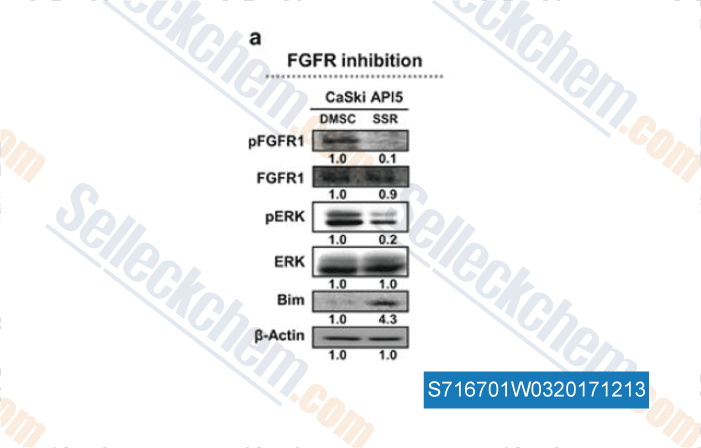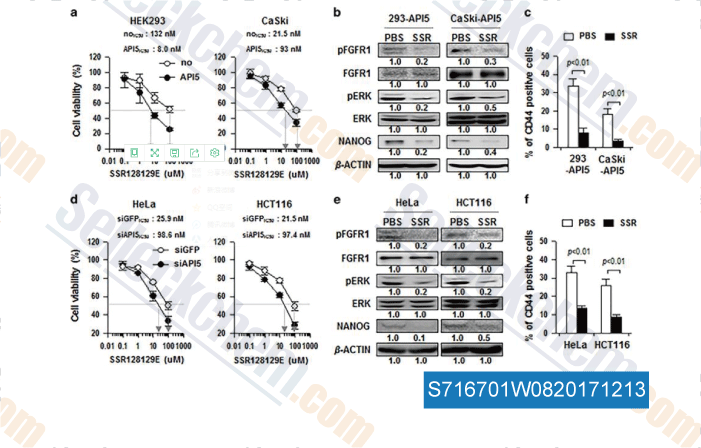|
Toll Free: (877) 796-6397 -- USA and Canada only -- |
Fax: +1-832-582-8590 Orders: +1-832-582-8158 |
Tech Support: +1-832-582-8158 Ext:3 Please provide your Order Number in the email. |
Technical Data
| Formula | C18H15N2O4.Na |
||||||||||
| Molecular Weight | 346.31 | CAS No. | 848318-25-2 | ||||||||
| Solubility (25°C)* | In vitro | DMSO | 69 mg/mL (199.24 mM) | ||||||||
| Water | 1 mg/mL (2.88 mM) | ||||||||||
| Ethanol | Insoluble | ||||||||||
| In vivo (Add solvents to the product individually and in order) |
|
||||||||||
|
* <1 mg/ml means slightly soluble or insoluble. * Please note that Selleck tests the solubility of all compounds in-house, and the actual solubility may differ slightly from published values. This is normal and is due to slight batch-to-batch variations. * Room temperature shipping (Stability testing shows this product can be shipped without any cooling measures.) |
|||||||||||
Preparing Stock Solutions
Biological Activity
| Description | SSR128129E is an orally-active and allosteric FGFR1 inhibitor with IC50 of 1.9 μM, while not affecting other related RTKs. | ||
|---|---|---|---|
| Targets |
|
||
| In vitro | SSR128129E exhibits more effective activity in cell assay due to its allosteric mechanism. SSR128129E dose-dependently inhibits FGF2-induced EC proliferation and migration with IC50 of 31 nM and 15.2 nM, respectively. As a multi-FGFR inhibitor, SSR128129E inhibits responses mediated by FGFR1-4 and thus results in the blockage of proliferation and/or migration in various cell lines including mPanc02, HEK-hFGFR2WT, PAE-hFGFR1, hB9-myeloma and HUVEC. [1] | ||
| In vivo | In Arthritis mice, SSR128129E (30 mg/kg, p.o.) inhibits angiogenesis, inflammation, and bone resorption, and reduces the severity of clinical symptoms. In mice bearing various tumor models, SSR128129E (30 mg/kg, p.o.) inhibits both the growth of primary tumors and metastasis. In addition, SSR128129E inhibits growth of anti-VEGFR2-refractory and -sensitive tumor models, and enhances the antitumor activity of anti-VEGFR2. [1] SSR128129E also inhibits arteriosclerosis in a mouse vein graft model and atherosclerosis in apolipoprotein E-deficient mice. [2] |
Protocol (from reference)
| Kinase Assay: |
|
|---|---|
| Cell Assay: |
|
| Animal Study: |
|
References
|
Customer Product Validation

-
Data from [Data independently produced by , , Exp Mol Med, 2017, 49(9):e374]

-
Data from [Data independently produced by , , Oncogenesis, 2017, 6(1):e285]
Selleck's SSR128129E has been cited by 9 publications
| FGF-2 promotes angiogenesis through a SRSF1/SRSF3/SRPK1-dependent axis that controls VEGFR1 splicing in endothelial cells [ BMC Biol, 2021, 19(1):173] | PubMed: 34433435 |
| MEKK1 Regulates Chemokine Expression in Mammary Fibroblasts: Implications for the Breast Tumor Microenvironment [ Front Oncol, 2021, 11:609918] | PubMed: 33868996 |
| Extracellular vesicles from human airway basal cells respond to cigarette smoke extract and affect vascular endothelial cells [ Sci Rep, 2021, 11(1):6104] | PubMed: 33731767 |
| Cisplatin Resistance in Osteosarcoma: In vitro Validation of Candidate DNA Repair-Related Therapeutic Targets and Drugs for Tailored Treatments. [ Front Oncol, 2020, 10;10:331] | PubMed: 32211337 |
| VEGF pathway-targeting drugs induce evasive adaptation by activation of neuropilin-1/cMet in colon cancer cells. [ Int J Oncol, 2018, 52(4):1350-1362] | PubMed: 29532881 |
| API5 induces cisplatin resistance through FGFR signaling in human cancer cells. [Jang HS, et al. Exp Mol Med, 2017, 49(9):e374] | PubMed: 28883546 |
| API5 confers cancer stem cell-like properties through the FGF2-NANOG axis. [Song KH, et al. Oncogenesis, 2017, 6(1):e285] | PubMed: 28092370 |
| Ferulic Acid Exerts Anti-Angiogenic and Anti-Tumor Activity by Targeting Fibroblast Growth Factor Receptor 1-Mediated Angiogenesis. [ Int J Mol Sci, 2015, 16(10):24011-31] | PubMed: 26473837 |
| Integration of signals along orthogonal axes of the vertebrate neural tube controls progenitor competence and increases cell diversity [ PLoS Biol, 2014, 12(7):e1001907] | PubMed: 25026549 |
RETURN POLICY
Selleck Chemical’s Unconditional Return Policy ensures a smooth online shopping experience for our customers. If you are in any way unsatisfied with your purchase, you may return any item(s) within 7 days of receiving it. In the event of product quality issues, either protocol related or product related problems, you may return any item(s) within 365 days from the original purchase date. Please follow the instructions below when returning products.
SHIPPING AND STORAGE
Selleck products are transported at room temperature. If you receive the product at room temperature, please rest assured, the Selleck Quality Inspection Department has conducted experiments to verify that the normal temperature placement of one month will not affect the biological activity of powder products. After collecting, please store the product according to the requirements described in the datasheet. Most Selleck products are stable under the recommended conditions.
NOT FOR HUMAN, VETERINARY DIAGNOSTIC OR THERAPEUTIC USE.
